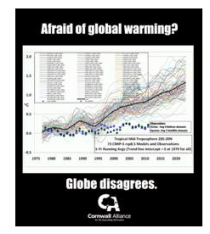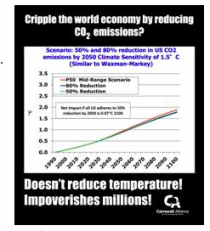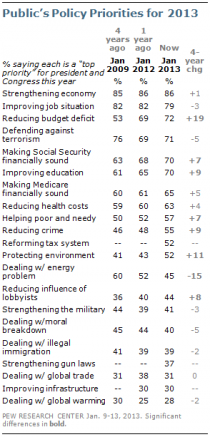David R. Legates, Ph.D.
Recently, my fellow evangelical scientists and academics sent a letter to the United States Congress urging immediate legislation on climate change. In an effort to care for the planet - God’s second greatest gift to humanity - they argue that our uncontrolled use of fossil fuels will disproportionately affect the poor, the vulnerable, and the oppressed.
I applaud their concern for the environment and for those in defense of whom Jesus commanded us to be especially diligent. But their call to reduce carbon emissions would do more harm than good, especially to the “least of these” as referenced by Christ.
Average global temperatures have not risen over at least the past fifteen years. Dr. John Christy, a fellow evangelical Christian and a highly respected climatologist, testified to Congress that in the United States, we have seen virtually no change in daily maximum temperature, while most of the warming is confined to increases in daily minimum temperatures. (Nighttime temperatures are driven by turbulence [or lack of it] near the surface, not CO2 warming. By contrast, daytime maximum temperature is a much better measure of warming from greenhouse gases. The lack of a signal in daily maximum temperature suggests that the rate of warming due to CO2 is relatively small.) That and the lack of warming for at least a decade and a half implies the effect of CO2 warming is much smaller than climate models suggest.

Contrary to claims in the recent letter, a report issued last summer by the Intergovernmental Panel on Climate Change on extreme events indicated that droughts “have become less frequent, less intense, or shorter, for example, in Central North America.” The percentage of the United States classified in moderate-to-extreme dryness and wetness as presented by the National Oceanographic and Atmospheric Administration (NOAA) shows high variability but no significant trend. NOAA also concludes that snowfall records show no long-term trend and that recent record snowfalls are the result of natural variability, not global warming. Hurricane activity globally is at a thirty-year low, and the frequency of moderate to severe tornadoes (EF3-EF5) has not increased. Sea levels have been rising at about the same pace since well before greenhouse gases began to rise from fossil fuel emissions.
Draconian legislation to curtail energy use by restricting fossil fuel emissions will have little, if any, impact on Earth’s climate. A 50% reduction in CO2 emissions by 2050 would only reduce global average temperature in 2100 by an inconsequential 0.07C. Even an elimination of all CO2 emissions by the United States would prevent only 0.17C of warming.

Instead of fighting global warming, the most important environmental task facing Christians today is economic development, because poverty is the greatest threat to both human well-being and the environment.
We need to find more efficient ways to use energy and more sources for energy to keep the cost low. Why? If we make energy so expensive that only the rich can afford it, then the poor and the vulnerable will be denied access. That will condemn them to a life of poverty, sickness, and low life expectancy.
Moreover, the environment itself suffers because when a people are in dire need of food, clothing, shelter, and other necessities, they cannot be concerned with environmental issues. The Ganges River, for example, is both the source of ‘clean’ drinking water and the reservoir for untreated sewage. Why? Because the people are so poor. Technological development would enable them to afford water and sewage treatment. High-tech, high-yield farming methods would increase food supplies. Natural gas and electricity would heat homes and cook food without cutting forests and burning wood and dung, which degrade indoor air quality and cause lethal lung infections. Refrigeration would mean the poor do not have to choose between eating spoiled food and going hungry.
Furthermore, oppression thrives when energy is restricted. Totalitarian regimes remain in power by keeping their subjects poor and deprived of technological amenities. Freedom spreads when people have time and ability to travel and communicate, to develop ideas and concepts, and to organize against a common enemy and for a better way of life. Energy, therefore, is the life blood to ending poverty and oppression.
In the Parable of the Talents (Matthew 25:14-28), Jesus told of a master who entrusted his money to three servants. The first two put the talents to use and presented the master with more than they had been given. The third, whom Christ called ‘worthless’, hid his talent in the ground.
Often we think of the talents as money or ability, but they really stand for every resource. If we needlessly leave resources ‘hidden’ in the ground, will we be met with the same rebuke from the “Master of All Creation”?
In America and around the world, people are hurting now. I pray that my Brothers and Sisters in Christ see their need and respond accordingly, rather than limiting energy affordability and making life today more difficult for the poor, the vulnerable, and the oppressed.
Dr. David R. Legates, a Christian and a Professor of Climatology at the University of Delaware, is a Senior Fellow of the Cornwall Alliance for the Stewardship of Creation - a coalition of clergy, theologians, scientists, economists, and policy experts committed to bringing a balanced Biblical view of stewardship to environmental and developmental issues.
Evangelical Scientists and Academics’ Mistaken in Urging Congress to Act on Climate
by E. Calvin Beisner
Climatologist Dr. David Legates’s response above to the letter from “evangelical scientists and academics” urging Congress to immediate action to fight global warming by reducing fossil fuel use points out some of its factual inaccuracies and the harms that would be done by acting on its advice.
It’s also interesting to look at the letter as an example of misleading policy-related communications.
One would naturally expect that a letter addressing climate change and starting with “As evangelical scientists and academics, we understand climate change is real and action is urgently needed” would have among its signers a host of climate scientists. Indeed, a reporter for ClimateWire, a publication of Environment & Energy Publishing, Inc., thought so. She emailed me asking, “Did you expect this collection of 200 Evangelical scientists, all with degrees in climate science, to promote their studies with a faith-led banner?”
But out of the 194 signers, we’ve been able to identify only five climate scientists (2.6%), while by far the largest field of study represented is biology, with 117 (60.3%). Heres the complete breakdown:
Atmospheric Science/Meteorology/Climatology: 5 (2.6%)
Biology : 117 (60.3%)
Chemistry: 29 (14.9%)
Computer Science and Mathematics: 3 (1.5%)
Engineering: 10 (5.6%)
Environmental Sciences: 2 (1.3%)
Geography: 1 (0.5%)
Geology: 11 (5.7%)
Medicine: 1 (0.5%)
Paleontology: 2 (1.3%)
Physics: 10 (5.6%)
Unidentified: 3 (1.5%)
No wonder the organizers listed only names and institutions, not the fields in which they taught! The vast majority are not climate scientists and almost certainly are unfamiliar with the enormous controversy raging among climatologists, meteorologists, and other climate scientists over such fundamental questions as “How much warming - after climate feedbacks would be cause by doubled atmospheric CO2 concentration?” Granted the mainstream media’s failure to report it, almost none would be familiar with the fact that there’s been no statistically significant global warming for at least 15 years, probably over 17, and possibly as many as 23 a fact nearly impossible to reconcile with the theories behind the computer climate models underlying fears of dangerous warming.
Conspicuously absent from the list of signers are economists - of any specialty whatever, but particularly of environment, energy, and development - who would have the expertise to evaluate the probable impact of climate policy on human welfare. Many such scholars believe rushing to replace fossil fuels with “Green” energy would cause enormous harm to the world’s poor.
That raises an irony in the recent letter. It cites Romans 13:10 as saying “Love does no harm to its neighbor,” and argues from it that we must cut fossil fuel use to prevent global warming. But raising the price of energy, as would necessarily happen under the letter’s prescription, harms the very people the signers say they want to protect. Indeed, over 28,000 people died in the U.K. in the bitter winter of 2011-2012 because high energy prices, driven upward by Britain’s aggressive policy to replace fossil fuels with wind and solar, forced them into “fuel poverty”: they couldn’t afford both food and heat for their homes.
Evangelicals need to do much better than to repeat the mantras of global warming alarmists. They need to study the controversy in depth for themselves. The letter’s signers could do worse than to begin by reading the Cornwall Alliance’s A Renewed Call to Truth, Prudence, and Protection of the Poor: An Evangelical Examination of the Theology, Science, and Economics of Global Warming.
From CSIRO and “increased CO2 has benefits” department:
Satellite data shows the per cent amount that foliage cover has changed around the world from 1982 to 2010. Click here for a full-sized and detailed image.

Increased levels of carbon dioxide (CO2) have helped boost green foliage across the world’s arid regions over the past 30 years through a process called CO2 fertilisation, according to CSIRO research.
In findings based on satellite observations, CSIRO, in collaboration with the Australian National University (ANU), found that this CO2 fertilisation correlated with an 11 per cent increase in foliage cover from 1982-2010 across parts of the arid areas studied in Australia, North America, the Middle East and Africa, according to CSIRO research scientist, Dr Randall Donohue.
“In Australia, our native vegetation is superbly adapted to surviving in arid environments and it consequently uses water very efficiently,” Dr Donohue said. “Australian vegetation seems quite sensitive to CO2 fertilisation.
The fertilisation effect occurs where elevated CO2 enables a leaf during photosynthesis, the process by which green plants convert sunlight into sugar, to extract more carbon from the air or lose less water to the air, or both.
This, along with the vast extents of arid landscapes, means Australia featured prominently in our results.”
“While a CO2 effect on foliage response has long been speculated, until now it has been difficult to demonstrate,” according to Dr Donohue.
“Our work was able to tease-out the CO2 fertilisation effect by using mathematical modelling together with satellite data adjusted to take out the observed effects of other influences such as precipitation, air temperature, the amount of light, and land-use changes.”
The fertilisation effect occurs where elevated CO2 enables a leaf during photosynthesis, the process by which green plants convert sunlight into sugar, to extract more carbon from the air or lose less water to the air, or both.
If elevated CO2 causes the water use of individual leaves to drop, plants in arid environments will respond by increasing their total numbers of leaves. These changes in leaf cover can be detected by satellite, particularly in deserts and savannas where the cover is less complete than in wet locations, according to Dr Donohue.
“On the face of it, elevated CO2 boosting the foliage in dry country is good news and could assist forestry and agriculture in such areas; however there will be secondary effects that are likely to influence water availability, the carbon cycle, fire regimes and biodiversity, for example,” Dr Donohue said.
“Ongoing research is required if we are to fully comprehend the potential extent and severity of such secondary effects.”
This study was published in the US Geophysical Research Letters journal and was funded by CSIRO’s Sustainable Agriculture Flagship, Water for a Healthy Country Flagship, the Australian Research Council and Land & Water Australia.
ICECAP NOTE: See how this corroborates this analysis about the 2012 drought and crops.
Source: Wash Post
by Charles Krauthammer
The economy stagnates. Syria burns . Scandals lap at his feet. China and Russia mock him , even as a “29-year-old hacker” revealed his nation’s spy secrets to the world. How does President Obama respond? With a grandiloquent speech on climate change .
Climate change? It lies at the very bottom of a list of Americans’ concerns (last of 21 - Pew poll).
Which means that Obama’s declaration of unilateral American war on global warming, whatever the cost and it will be heavy is either highly visionary or hopelessly solipsistic. You decide:
Global temperatures have been flat for 16 years - a curious time to unveil a grand, hugely costly, socially disruptive anti-warming program.
Now, this inconvenient finding is not dispositive. It does’t mean there is no global warming. But it is something that the very complex global warming models that Obama naively claims represent settled science have trouble explaining. It therefore highlights the president’s presumption in dismissing skeptics as flat-earth know-nothings.
On the contrary. It’s flat-earthers like Obama who refuse to acknowledge the problematic nature of contradictory data. It’s flat-earthers like Obama who cite a recent Alaskan heat wave ‘ a freak event in one place at one time - as presumptive evidence of planetary climate change. It’s flat-earthers like Obama who cite perennial phenomena such as droughts as cosmic retribution for environmental sinfulness.
For the sake of argument, nonetheless, let’s concede that global warming is precisely what Obama thinks it is. Then answer this: What in God’s name is his massive new regulatory and spending program which begins with a war on coal and ends with billions in more subsidies for new Solyndras going to do about it?
The United States has already radically cut carbon dioxide emissions more than any country on earth since 2006, according to the International Energy Agency. Emissions today are back down to 1992 levels.
And yet, at the same time, global emissions have gone up. That’s because - surprise! - we don’t control the energy use of the other 96 percent of humankind.
At the heart of Obama’s program are EPA regulations that will make it impossible to open any new coal plant and will systematically shut down existing plants. “Politically, the White House is hesitant to say they’re having a war on coal,” explained one of Obama’s climate advisers. ‘On the other hand, a war on coal is exactly what’s needed.”
Net effect: tens of thousands of jobs killed, entire states impoverished. This at a time of chronically and crushingly high unemployment, slow growth, jittery markets and deep economic uncertainty.
But that’s not the worst of it. This massive self-sacrifice might be worthwhile if it did actually stop global warming and save the planet. What makes the whole idea nuts is that it won’t. This massive self-inflicted economic wound will have no effect on climate change.
The have-nots are rapidly industrializing. As we speak, China and India together are opening one new coal plant every week. We can kill U.S. coal and devastate coal country all we want, but the industrializing Third World will more than make up for it. The net effect of the Obama plan will simply be dismantling the U.S. coal industry for shipping abroad.
To think we will get these countries to cooperate is sheer fantasy. We’ve been negotiating climate treaties for 20 years and gotten exactly nowhere. China, India and the other rising and modernizing countries point out that the West had a 150-year industrial head start that made it rich. They are still poor. And now, just as they are beginning to get rich, we’re telling them to stop dead in their tracks?
Fat chance. Obama imagines he’s going to cajole China into a greenhouse-gas emissions reduction that will slow its economy, increase energy costs, derail industrialization and risk enormous social unrest. This from a president who couldn’t even get China to turn over one Edward Snowden to U.S. custody.
I’m not against a global pact to reduce CO2. Indeed, I favor it. But in the absence of one, and there is no chance of getting one in the foreseeable future, there is no point in America committing economic suicide to no effect on climate change, the reversing of which, after all, is the alleged point of the exercise.
For a president to propose this with such aggressive certainty is incomprehensible. It is the starkest of examples of belief that is impervious to evidence. And the word for that is faith, not science.
--------
Speaking of follies....here is another from Mayor Bloomberg. Little Napolean goes off his rocker once again:
NYC Mayor Bloomberg Pushes Mandatory Composting
Cheryl K. Chumley

Mayor Michael Bloomberg - the man who brought about the failed supersize soda ban and restrictions on trans fats in city restaurants - is pushing for a law forcing New York City residents to compost their food refuse.
Bloomberg’s proposal would encourage voluntary composting initially, and then make food composting mandatory by 2015-2016.
Another Consumer Mandate
Opponents decried yet another expansion of the nanny state and also worried about food composting expanding the city’s rat population.
“People seem to be able to recycle their paper and bottles without too much trouble, despite lots of outcry when it first started decades ago,” said Nicole Gelinas, a Searle Freedom Trust Fellow at the Manhattan Institute. “I think the point of the expanded voluntary pilot is to see if they can do this, too, or if it causes too many problems with improperly disposed waste - rats, etc.”
“Garbage sits around attracting rats no matter what. I’m not sure if it will attract more rats just by being in separately sealed containers,… but I guess we will find out,” said Gelinas.
Voluntary vs. Mandatory Composting
Gelinas called the proposal “fine on a voluntary basis” but only if residents and apartment owners can reach agreement on the issue.
During his State of the City address earlier this year, Bloomberg called food waste “New York City’s final recycling frontier.” His office is negotiating with a composting plant that can handle up to 100,000 tons of food waste per year, roughly 10 percent of the food waste that’s thrown into the garbage from the city’s dining tables.
Jeff Stier, the New York City-based director of the National Center for Public Policy Research’s Risk Analysis Division, notes the city already has a voluntary composting program. He questions the need and desirability of a mandatory program.
Long List of Targets
Stier says Bloomberg’s proposal is just one more way for the mayor to implement a nanny state before his last months in office wrap up. Stier noted Bloomberg has put the force of city government into opposition to trans fats, salt, Styrofoam containers, soda, and other food substances and consumer products.
“He’s done all sorts of thing to try to control what we eat,” he said. “He’s trying to control the containers that hold our food. And now he’s trying to control what we don’t eat, with compost.”
Once the program moved from voluntary to mandatory, it would impose fines on people who don’t comply.
Collateral Environmental Damage
Stier notes the trucks that will be necessary to collect the food waste will put more vehicles on New York City streets, consume more oil and gas, and emit more pollutants into the city’s air.
“There’s no way food scraps can be picked up from every home throughout the city without greatly increasing the number of trucks, traffic, and tyranny,” Stier explained.
Cheryl Chumley, ckchumley@aol.com, is a news writer with The Washington Times.
---------
Feds Give Wind Producers Free Pass to Kill Condors
By Karen Dove
Federal wildlife officials announced they will allow wind producers in California’s Tehachapi Mountains to kill endangered California condors without fear of prosecution. The U.S. Fish and Wildlife Service said the free pass will apply only when wind power companies inadvertently kill or harass the large and highly endangered birds, but such harassment and deaths are a foreseeable and unavoidable consequence of “green” wind power.
Recovering Condors at Risk
The California condor nearly went extinct in the 1970s and 1980s, with the number of wild birds bottoming out at 25 in 1975. Wild condor populations have rebounded to 150 today, but the species is still highly endangered.

Environmental Groups Outraged
Conservation and wildlife groups worry an expansion of wind power production in California condor habitat will reverse recent condor population gains and kill them as regularly as turbines kill protected golden eagles in California golden eagle habitat.
Environmental groups including the American Bird Conservancy, Center for Biological Diversity, and the Audubon Society immediately criticized Fish and Wildlife’s decision to give wind power companies a free pass to kill endangered condors.
“Allowing the legal killing of one of the imperiled birds in the United States threatens endangered species conservation efforts across the country,” Kelly Fuller, a coordinator with the American Bird Conservancy, said in a press statement.
“I can’t believe the federal government is putting so much money into a historic and costly effort to establish a stable population of condors, and at the same time is issuing permits to kill them. Ludicrous,” Kerncrest Audubon treasurer Daniel Burnett told the Los Angeles Times.
Documented Environmental Destruction
California wind farms already present a killing field for endangered and protected birds. According to Save the Eagles International, more than 1,000 birds of prey die each year at California’s Altamont Pass wind farm. Wind turbines are already the leading cause of death for golden eagles in the Golden State, and conservationists point out condors are larger and less agile than golden eagles, putting them in even greater danger from fast-spinning turbine blades.
Environmentalists have documented environmental damage already being caused by wind turbines in the Tehachapi Mountain area.
“All of this industrialization has taken its toll on the ecosystem. The nearby Pine Tree Wind project has one of the highest rates of golden eagle mortality per turbine in the country, and Next Era’s North Sky River Wind project killed its first golden eagle in January - within weeks of beginning operations,” reported the Mojave Desert Blog.
“The Alta East Wind project is expected to add to eagle mortality, although the U.S. Fish and Wildlife Service (FWS) admits that too little is known about the golden eagle population in the Mojave Desert to know if the deaths will result in the protected species’ decline,” the Mojave Desert Blog added.
Contradictory Policies
“The state of California allowing wind farms leeway in killing of condors and golden eagles flies in the face of reason,” said H. Sterling Burnett, senior fellow for the National Center for Policy Analysis.
Burnett pointed out the hypocrisy of giving California wind turbines a free pass to kill birds by the thousands while the California legislature imposes onerous restrictions on other activities with much more speculative and indirect impact on birds in the state.
The California Senate just passed a bill to make the ban on lead ammunition a statewide law, to protect the very same animals turbines endanger,” Burnett explained.
“In the eyes of California legislators and the Obama administration, oil refineries can be - and are - fined billions of dollars for offenses against protected wildlife, but it is OK to kill protected animals for the ‘cause’ of green energy,” Burnett noted. “This is indicative of the administration’s near-religious fervor for renewable energy despite the fact that the government has wasted billions of dollars on failed green energy companies.”
Karen Dove (karendove@icloud.com) is a freelance writer in Bradenton, Florida.
---------
Maryland Wind Farm Threatens Bald Eagles
Cheryl Chumley
U.S. Fish and Wildlife Service officials report a proposed wind energy project in Maryland would pose a “significant risk to eagles” and the developer should trim back its construction plans. The U.S. Navy has also expressed concern about the project, noting the turbines might skew nearby radar readings.
At Least 30 Eagles at Risk
U.S. Fish and Wildlife (FWS) biologists report at least 30 bald eagles nest within 10 miles of the proposed wind project. The proposed 60 turbines are too threatening to the eagles, and dozens could die each year, FWS wildlife officials say.
Also, the proposed Great Bay wind project in Somerset County is near enough the Patuxent River air base that Navy officials say the bounce-back from turbines will make it difficult to get accurate radar readings.
In response, Texas-based Pioneer Green Energy, which proposes to build the Great Bay wind project, is offering to cut back the number of turbines from 60 to 50.
“We are in the late stage development process of the project. For the past three years we have been studying the various aspects of project design,” said Pioneer Green Energy Vice President for Development Adam Cohen.
Cohen said he has also worked to minimize threats from “climate change and sea level rise on the Chesapeake Bay” and to “military operations in the area.”
High Costs for Minimal Power
But not all Marylanders are on board with the project.
Thomas Firey, a senior fellow with the Maryland Public Policy Institute and the author of an electricity primer for Maryland, says the project is rife with problems. Most notably, according to Firey, the project presents a questionable use of public funds to accomplish political, rather than practical or feasible, purposes.
“There are four different subsidies hidden in this,” Firey said, “and besides the explicit subsidy the legislature creates, it triggers others.”
Firey said for all the subsidies and preferential treatment, the project will generate “only a relatively small amount of electricity. It’s not going to have any effect on global warming....At best, [the project’s] meaningless. At worst, it puts Maryland residents on the hook for higher energy costs.”
Subsidies Make Situation Worse
Firey is not alone in expressing skepticism about the project. Jonathan Lesser, president of Continental Economics Inc., says wind power is not cost-efficient or economically feasible despite 35 years of subsidies. In addition, offshore wind developments are even more expensive than conventional wind projects, he says.
“Wind energy is not economic, ... [and] subsidies do not work,” Lesser said. “Subsidies may decrease prices in the short run, but they drive out investment in the long run and create uncertainty, which leads to higher prices than would prevail without subsidies.”
“Thatís free-lunch economics” and it doesn’t work, Lesser said. “And offshore wind is at least twice as costly as onshore wind. Regulators have had to resort to forcing utilities to purchase it.”
Cheryl Chumley (ckchumley@aol.com) is a news writer with The Washington Times.



